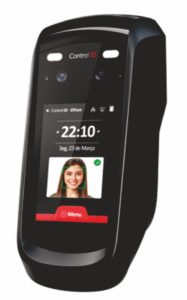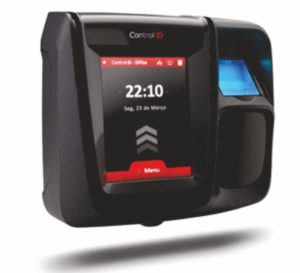![]() Walk into any modern facility today—whether it’s a tech park in Bengaluru, a logistics hub in Gurugram, or a commercial tower in Mumbai. What do you notice?
Walk into any modern facility today—whether it’s a tech park in Bengaluru, a logistics hub in Gurugram, or a commercial tower in Mumbai. What do you notice?
 Security guards are still there. However, they’re no longer flipping through visitor logbooks or manually opening gates. They’re working in sync with biometric terminals which instantly recognize faces, verify entries, and log every movement to a central dashboard.
Security guards are still there. However, they’re no longer flipping through visitor logbooks or manually opening gates. They’re working in sync with biometric terminals which instantly recognize faces, verify entries, and log every movement to a central dashboard.
This pairing: leveraging the reliability of human presence with the precision of biometric authentication and the vigilance of AI-driven surveillance is perhaps the most effective shift in the security industry. In regions like India, where trained manpower is both available and cost-effective, this model offers the best of all worlds: resourceful, resilient and responsive, even at scale.
Isn’t Technology and AI Enough?
Biometric systems have evolved far beyond basic fingerprint scans. Today, Control iD face recognition terminals come equipped with dual 1080p cameras (visible and infrared) that deliver high-accuracy readings even in poor lighting conditions. With a face detection range of up to 6 feet, multilingual audio prompts, and storage for over 10,000 identities, these devices cater to large workforces, multi-shift operations, and diverse visitor flows. Add support for PIN codes, RFID, and QR codes, and you have a single device that adapts to varied authentication needs.
Yet, technology alone isn’t the answer. A common misconception is that more automation always equals better control. But in practice, facilities that capitalize on available resources, both human and technological, build more intelligent and resilient security systems. Guards provide context, escalate incidents, offer situational judgment and act as immediate responders in ways even the most advanced AI cannot replicate.
Biometric + Guarding + Surveillance
It’s this integration that creates seamless facility management. Consider a large corporate building. A Control iD terminal verifies the identity of every entrant. Simultaneously, AI-powered surveillance cameras scan for tailgating, loitering, and unusual behavior, alerting command centers in real time. Nearby, a trained guard receives that alert, verifies the situation visually and takes necessary action, whether it’s directing a person to the help desk or contacting higher security.
Rather than overburdening guards with routine verification or asking machines to handle exceptions, this system divides labor intelligently. Biometrics verify. AI analyze and deduce. Humans act.
 This hybrid approach also delivers real operational benefits. Facility managers can reduce paperwork and manual logs while gaining real-time visibility into entry/exit data, footfall trends and access violations. Security officers can cover more ground with less effort, aided by digital alerts and centralized dashboards. Visitors and staff experience faster, smoother check-ins without compromising on security. And most importantly, the entire operation becomes scalable and audit friendly.
This hybrid approach also delivers real operational benefits. Facility managers can reduce paperwork and manual logs while gaining real-time visibility into entry/exit data, footfall trends and access violations. Security officers can cover more ground with less effort, aided by digital alerts and centralized dashboards. Visitors and staff experience faster, smoother check-ins without compromising on security. And most importantly, the entire operation becomes scalable and audit friendly.
Suitability for India:
In India, where facilities often operate across multiple shifts and thousands of employees, this model is especially effective. Post-pandemic policies have increased demand for non-contact verification, while compliance regulations have tightened around time and attendance tracking. Systems like Control iD ensure facilities remain compliant without slowing down operations. Meanwhile, the availability of trained on-ground personnel allows organizations to maintain a responsive human layer without excessive costs.
 AI surveillance also plays a crucial supporting role. In high-risk or high-traffic areas—like parking lots, server rooms, or warehouse docks—cameras equipped with object recognition, motion detection, and thermal sensing can track patterns, detect anomalies, and send instant alerts. But again, it’s the human guard who confirms the risk and acts on it. The technology extends their eyes and ears. The decision still rests with a trained professional.
AI surveillance also plays a crucial supporting role. In high-risk or high-traffic areas—like parking lots, server rooms, or warehouse docks—cameras equipped with object recognition, motion detection, and thermal sensing can track patterns, detect anomalies, and send instant alerts. But again, it’s the human guard who confirms the risk and acts on it. The technology extends their eyes and ears. The decision still rests with a trained professional.
The future of access control, especially in emerging markets, doesn’t lie in replacing guards with machines. It lies in orchestrating them. Smart devices like Control iD offer speed and traceability. Surveillance offers visibility and foresight. Human guards bring discernment, empathy, and action. Together, they form a secure, seamless system that scales effortlessly and adapts continuously.
Access control doesn’t need to only be futuristic to be transformative. In many ways, the most successful systems are the ones that balance technological innovation with human judgment. The future isn’t about replacing one with the other. It’s about integration—smart machines for precision and speed and skilled people for responsiveness and context.
The answer? A model of synergy—not substitution—that reduces errors, ensures compliance and improves response times.























































